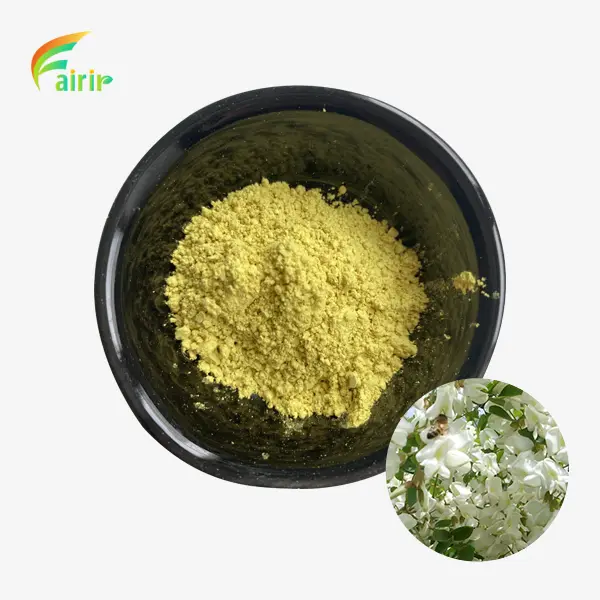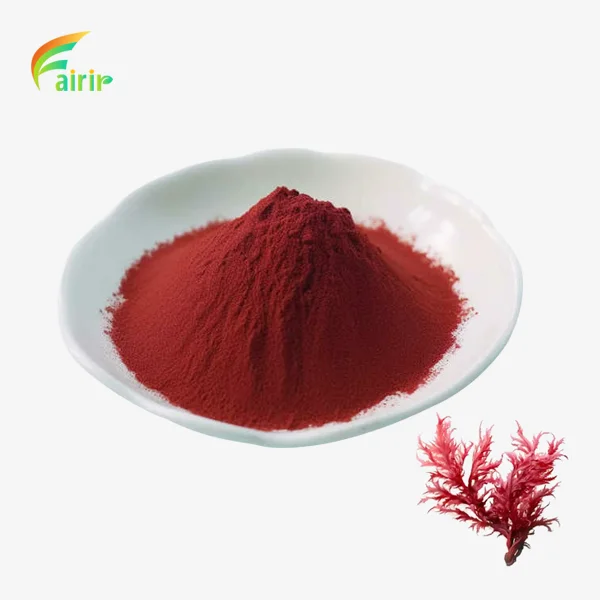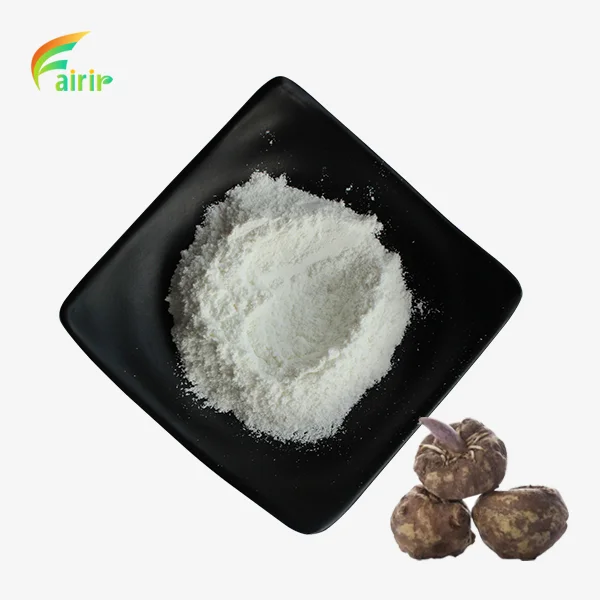What are the safety and dosage guidelines for Pure Artemisinin Powder?
Pure Artemisinin Powder, derived from the Artemisia annua plant, has gained significant attention in recent years due to its potent antimalarial properties. As a key component in Artemisinin-based Combination Therapies (ACTs), it plays a crucial role in combating malaria worldwide. However, like any powerful medication, it's essential to understand the safety considerations and proper dosage guidelines to ensure its effective and safe use. This blog post aims to explore the important aspects of Pure Artemisinin Powder, including its recommended dosages, potential side effects, and safety precautions. By delving into these topics, we hope to provide valuable insights for healthcare professionals, researchers, and individuals interested in the applications of this remarkable compound. Understanding these guidelines is crucial for maximizing the benefits of Pure Artemisinin Powder while minimizing potential risks.

What are the recommended dosage levels for Pure Artemisinin Powder?
How is the dosage determined for adults?
Determining the appropriate dosage of Pure Artemisinin Powder for adults is a critical aspect of its use in malaria treatment. The standard recommended dose for adults typically ranges from 2 to 4 mg per kilogram of body weight, administered once daily for 3 to 7 days, depending on the severity of the infection and the specific treatment protocol. However, it's important to note that Pure Artemisinin Powder is rarely used alone and is usually combined with other antimalarial drugs in ACTs. The exact dosage may vary based on factors such as the patient's weight, age, and the particular combination therapy being used. Healthcare providers must carefully calculate the dosage to ensure optimal efficacy while minimizing the risk of side effects. It's crucial to follow the prescribed dosage regimen strictly to prevent the development of drug resistance and ensure the best possible treatment outcomes.
What are the dosage recommendations for children?
Dosage recommendations for children using Pure Artemisinin Powder require special attention due to their smaller body size and different metabolic rates. Generally, the dosage for children is calculated based on their body weight, similar to adults, but with additional considerations. The typical range is 2 to 4 mg per kilogram of body weight, adjusted according to age and weight. For infants and young children, the powder may be formulated into a suspension or incorporated into pediatric-friendly dosage forms. It's crucial to note that the use of Pure Artemisinin Powder in very young children and infants should be under strict medical supervision. Healthcare providers must carefully balance the need for effective treatment with the potential risks associated with the medication. Parents and caregivers should be educated on the importance of adhering to the prescribed dosage and schedule to ensure the child receives the full benefits of the treatment while minimizing the risk of adverse effects.
Are there special dosage considerations for pregnant women?
The use of Pure Artemisinin Powder during pregnancy requires careful consideration due to the potential risks to the developing fetus. Artemisinin-based treatments should not be used during the first three months of pregnancy unless there are no other options that work or the mother's life is in danger. In the second and third trimesters of pregnancy, the World Health Organization (WHO) says that combining treatments based on artemisinin should be used. These therapies should include Pure Artemisinin Powder because they are safer during these times. Pregnant women should usually take the same amount of medicine as adults, but they should be closely watched for any bad effects. When doctors give Pure Artemisinin Powder to pregnant women, they have to weigh the benefits of healing malaria against the possible risks to the baby. To protect both the mother and the baby, it is very important for pregnant women to get their antimalarial drugs under close medical care.
What are the potential side effects of Pure Artemisinin Powder?
What are the common mild side effects?
While Pure Artemisinin Powder is generally well-tolerated, some users may experience mild side effects. These common side effects are typically transient and often resolve on their own without requiring discontinuation of the treatment. Users of Pure Artemisinin Powder may experience symptoms such as nausea, vomiting, dizziness, and headache. Some individuals might also report mild abdominal discomfort or diarrhea.It's important to keep in mind that these side effects can be hard to tell apart from malaria signs. Some users may have mild allergy responses less often, like getting rashes or itching on their skin. Most of the time, these side effects aren't very bad, but they should still be closely watched. If any of these symptoms last longer than a few days or get worse, you should see a doctor. Understanding these potential mild side effects can help users and healthcare providers better manage the treatment and ensure patient comfort during the course of therapy with Pure Artemisinin Powder.
Are there any serious adverse reactions to be aware of?
While serious adverse reactions to Pure Artemisinin Powder are rare, they can occur and require immediate medical attention. One of the biggest worries is that people could have serious allergic responses, like anaphylaxis. Even though it doesn't happen often, people who use it should be on the lookout for symptoms like a serious rash, trouble breathing, or swelling in the face, lips, tongue, or throat. Neurotoxicity is a rare but dangerous side effect that can show up as confusion, seizures, or other neurological signs. There have also been reports of blood problems, such as a drop in the number of white blood cells or platelets, which can make getting infections or bleeding more likely. Liver function problems are rare, but they have been seen in some cases. Doctors and nurses should keep a close eye on their patients for any signs of these dangerous side effects, especially in people who already have health problems or who are taking other medicines. People who use Pure Artemisinin Powder need to be aware of these possible side effects and need to see a doctor right away if they have any strange or serious symptoms while they are taking the medicine.
How do drug interactions affect the safety profile?
Pure Artemisinin Powder's safety profile can be greatly affected by drug combinations, so it is very important for doctors to look at all of a patient's medications. One of the primary concerns is the potential interaction with drugs that affect liver enzymes, particularly those that induce or inhibit the CYP3A4 enzyme system. Medications that induce this enzyme may reduce the effectiveness of Pure Artemisinin Powder by increasing its metabolism, while inhibitors may lead to increased blood levels and potential toxicity. Certain antiretroviral drugs used in HIV treatment, for instance, can interact with artemisinin-based therapies. Additionally, there may be interactions with other antimalarial drugs, which is why artemisinin is typically used in combination therapies carefully designed to avoid antagonistic effects. Anticoagulants and antiplatelet drugs might also interact, potentially increasing the risk of bleeding. It's crucial for patients to disclose all medications, including over-the-counter drugs and herbal supplements, to their healthcare provider before starting treatment with Pure Artemisinin Powder to ensure its safe and effective use.
How should Pure Artemisinin Powder be stored and handled safely?
What are the proper storage conditions?
To keep Pure Artemisinin Powder working well and safe to use, it is important to store it the right way. Keep the powder somewhere cool and dry, out of direct sunlight and heat sources. In general, 15°C to 25°C (59°F to 77°F) is the best temperature range for keeping. The powder should be kept in its original, tightly sealed container to keep air and wetness out, which can break down the combination. Pure Artemisinin Powder that comes in single-dose packets should be kept closed until it's time to use. Controlling the humidity is very important because water can make the powder clump together and could even change how stable its chemicals are. Some makers may say to keep the food in the fridge for long-term storage, but it's very important to follow the exact storage directions that come with the food. Hospitals and shops should have good inventory management systems in place to make sure that older stock is used up first and that no dated goods are given out. The safety and effectiveness of Pure Artemisinin Powder can be maintained for as long as it is stored according to these rules.
What precautions should be taken when handling the powder?
Handling Pure Artemisinin Powder requires specific precautions to ensure safety and maintain the integrity of the product. To keep from breathing it in or touching it on your skin, it's important to wear the right personal safety equipment (PPE) when dealing with the powder. This includes gloves and a dust mask or respirator. Handling the powder should be done in a well-ventilated area, ideally under a fume hood if one is available, to lower the risk of particles getting into the air. It is important not to make too much dust when using Pure Artemisinin Powder, because the tiny particles can irritate the eyes, skin, and lungs. Use clean, dry containers and tools to measure or move the powder so that it doesn't get contaminated. Any spills should be cleaned up right away using the right methods, like wet cleaning, to keep the powder from spreading through the air. Also, make sure to wash your hands well after handling the powder, even if you wore gloves. For healthcare professionals or researchers working with Pure Artemisinin Powder regularly, it's advisable to undergo proper training on safe handling procedures to minimize risks associated with long-term exposure.
How long can Pure Artemisinin Powder be stored before expiration?
The shelf life of Pure Artemisinin Powder can vary depending on the manufacturer and storage conditions, but typically ranges from 2 to 3 years from the date of manufacture when stored properly. It's crucial to check the expiration date on the product packaging and adhere to it strictly. The stability of Pure Artemisinin Powder can be affected by various factors, including temperature fluctuations, humidity, and exposure to light. Even if stored under ideal conditions, the potency of the powder may gradually decrease over time. Some manufacturers may provide stability data that indicates the powder remains effective for a certain period beyond the printed expiration date, but this should not be relied upon without verification. Healthcare facilities and pharmacies should implement a first-in, first-out (FIFO) inventory system to ensure that older stock is used before it expires. Regular quality checks, including visual inspection for any changes in color or texture, can help identify potential degradation. If there's any doubt about the quality or efficacy of expired or near-expiry Pure Artemisinin Powder, it should not be used and should be disposed of according to local regulations for pharmaceutical waste.
Conclusion
In conclusion, understanding the safety and dosage guidelines for Pure Artemisinin Powder is crucial for its effective and safe use in malaria treatment. Proper dosing, awareness of potential side effects, and careful consideration of drug interactions are essential for healthcare providers and patients alike. Adhering to storage and handling protocols ensures the powder's potency and safety. While Pure Artemisinin Powder is a powerful tool in combating malaria, its use must be carefully managed to maximize benefits and minimize risks. For further information or inquiries about Pure Artemisinin Powder, please contact Shaanxi Fairir Biotech Co., Ltd. at sales@fairirbiotech.com.
References
1. World Health Organization. (2021). Guidelines for the treatment of malaria, 3rd edition.
2. Efferth, T. (2017). From ancient herb to modern drug: Artemisia annua and artemisinin for cancer therapy. Seminars in Cancer Biology, 46, 65-83.
3. Morris, C. A., Duparc, S., Borghini-Fuhrer, I., Jung, D., Shin, C. S., & Fleckenstein, L. (2011). Review of the clinical pharmacokinetics of artesunate and its active metabolite dihydroartemisinin following intravenous, intramuscular, oral or rectal administration. Malaria Journal, 10(1), 263.
4. Nosten, F., & White, N. J. (2007). Artemisinin-based combination treatment of falciparum malaria. The American Journal of Tropical Medicine and Hygiene, 77(6_Suppl), 181-192.
5. Clark, R. L. (2012). Effects of artemisinins on reticulocyte count and relationship to possible embryotoxicity in confirmed and unconfirmed malarial patients. Birth Defects Research Part A: Clinical and Molecular Teratology, 94(2), 61-75.
6. Dondorp, A. M., Nosten, F., Yi, P., Das, D., Phyo, A. P., Tarning, J., ... & White, N. J. (2009). Artemisinin resistance in Plasmodium falciparum malaria. New England Journal of Medicine, 361(5), 455-467.











_1751965378790.webp)